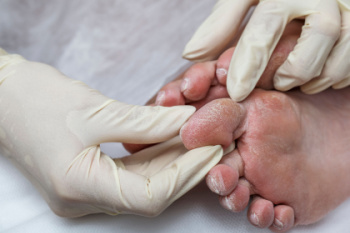Items filtered by date: May 2025
Diabetic Foot Blisters

Diabetic foot blisters, or diabetic bullae, are a rare, but important concern for people with diabetes. These fluid-filled blisters usually appear on the feet and can form without injury, often overnight. Although typically painless, they can become large and increase the risk of serious infection if not properly cared for. The exact cause is still unknown, but high blood sugar levels and diabetic neuropathy are thought to contribute. Blisters may heal on their own in a few weeks, but self-treatment can lead to complications. Infection, skin breakdown, and poor healing are real risks for diabetic patients. A podiatrist plays a key role in managing diabetic foot blisters. They can clean and protect the affected area, monitor for signs of infection, and provide foot care to prevent recurrence. Early treatment is key to avoiding more serious issues. If you have diabetic foot blisters, it is suggested that you schedule an appointment with a podiatrist for appropriate treatment.
Blisters are prone to making everyday activities extremely uncomfortable. If your feet are hurting, contact one of our podiatrists of Parkwood Podiatry. Our doctors can provide the care you need to keep you pain-free and on your feet.
Foot Blisters
Foot blisters develop as a result of constantly wearing tight or ill-fitting footwear. This happens due to the constant rubbing from the shoe, which can often lead to pain.
What Are Foot Blisters?
A foot blister is a small fluid-filled pocket that forms on the upper-most layer of the skin. Blisters are filled with clear fluid and can lead to blood drainage or pus if the area becomes infected.
How Do Blisters Form?
Blisters on the feet are often the result of constant friction of skin and material, usually by shoe rubbing. Walking in sandals, boots, or shoes that don’t fit properly for long periods of time can result in a blister. Having consistent foot moisture and humidity can easily lead to blister formation.
Prevention & Treatment
It is important to properly care for the affected area in order to prevent infection and ease the pain. Do not lance the blister and use a Band-Aid to provide pain relief. Also, be sure to keep your feet dry and wear proper fitting shoes. If you see blood or pus in a blister, seek assistance from a podiatrist.
If you have any questions, please feel free to contact our offices located in Brunswick and Hinesville, GA . We offer the newest diagnostic and treatment technologies for all your foot care needs.
